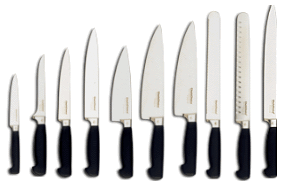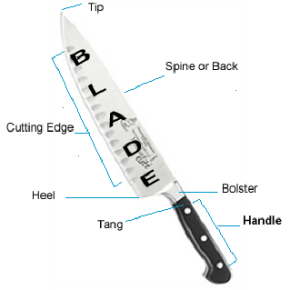|
Kitchenware -
Knives
- Part I
A guide to
choosing and buying knives
Anatomy of a Knife

Go to:-Â Â
Main Cookware Page
|
Buy Kitchenware
Both professional chefs and
retailers often have much to say when it comes to kitchen
knives, and one of the things you will often hear is "buy
expensive". However, although the price of a knife
may reflect its quality, in particular the way it has been
made or the material is has been made from, it doesn't always
indicate how easy it will be to use or how useful you will
find it in your kitchen. This comprehensive guide will help you to choose
and use the most appropriate knives for your particular
requirements.
Â
Â
Anatomy of a Knife
Â
Before you contemplate which knives you want or need, it
is a good idea to familiarise yourself with knife construction. Below is a
simple diagram showing the main elements of most kitchen knives.
Â
 |
Blade -
The term given to the whole of the metal part of
the knife
Tip/Point - The
pointed end of the blade
Spine/Back - The
blunt edge opposite to the blade's cutting edge
Cutting Edge - The
sharpened edge of the blade
Heel - The rear part of the blade
Bolster - The thick piece of metal between
the handle and the blade
Tang - The extension of the blade to which
the handle is attached
Handle - the part of the knife which is
held when using |
Â
Knife styles, blades, types and handles are discussed
more fully later, however we feel a special mention about the tang is
merited. The tang is the part of the blade which carries on through
the handle, often with rivets which are clearly visible in the handle above.
Â
|


